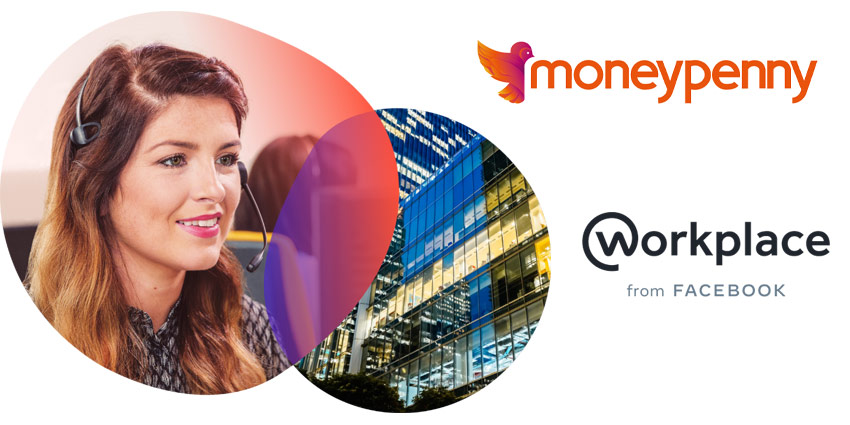Working remotely during the COVID-19 pandemic has been challenging for companies on a variety of fronts. Managing logistics to keep your operations up and running smoothly has been a top of list item for organizations of course.
But are they doing enough to support their team emotionally during these trying times? What steps are they taking to maintain their company culture and community when face-to-face human contact is not an option?
Many companies are turning to technology to help them overcome these challenges, keeping the flow of communication between team members flowing and identifying when they need to step in to provide additional mental health support.
UC Today recently spoke with the Wales-based answering service Moneypenny to hear how they are using Workplace from Facebook to stay attuned to the needs of their team and strengthen the community that they have spent the past 20 years building.
Why Moneypenny Chose Workplace

Headquartered in the North Wales city of Wrexham, Moneypenny prides itself on being the biggest employer in the area with a team of 750. Working with over 16,000 clients, Moneypenny CEO, Joanna Swash, tells UC Today that they have built a hard earned reputation for their dedicated receptionist services over the years.
“What’s really important to us is that our clients trust us and that we are looking after calls or chats just as if we’re based in the client’s office,” she says. “That trust is borne out of having the right people who are going to do the right thing at the right time. My only job is to keep our people happy and support them with the right technology that works, is robust, and is moving with the times to make sure that our service delivery is up to date.”
Along with investments in technology for handling incoming calls, Moneypenny sought out an internal communication tool for their employees.
Swash believes that creating a community feel out of your workforce can be empowering for businesses. “If you can make work part of people’s lives in a good way, not in a pressurized way, but one where they feel like they want to be involved in the community, then it has an impact on everything from engagement to staff churn to productivity,” she explains.
Moneypenny began using Workplace after the Christmas break in early 2017 while the product was still in Beta.
A key factor in deciding to integrate Workplace into their organisation was the look and feel of the UI. “It just feels so natural to use,” says Swash in describing the overall user experience of the platform.
She notes how everyone has become so used to Facebook’s platform that making the jump over to Workplace has been an easy one for their distributed team. “People just engage with it so naturally so you don’t have to force it on anybody,” she says, adding that, “It’s part of the routine in their lives.”
“Workplace for us has been absolutely fantastic in terms of the value that it has added to our business”
According to Swash, engagement with Workplace has been next to stellar with 85% of their team using the platform daily and 100% weekly.
While they already had high levels of engagement before the lockdown, going remote only increased the use of the platform.
Managing Connections and Mental Health for Remote Work
If you had asked Swash where making the transition to a home working arrangement for the entirety of her company was on her priorities list 2020, it is doubtful that it would have broken the top 20 — or even made the list at all.
But man plans and God laughs, so here we are.
Workplace has played a significant role in making the transition a smoother process, with Moneypenny’s team relying heavily on important features like the bots and chats.
Swash mentions that the bots helped them solve a number of logistical issues at the start of their transition preparations.
“Straight away when we knew that we’d have to move to a home working model, so we used the bot to ask our people if they already had laptops and broadband at home. It lets us gather all this information in a really user-friendly way,” she tells UC Today.
“We’ve also been using the ‘how do you feel bots’ to gauge mental health,” says Swash, noting that, ”For people who have been working remotely, I think that being able to monitor your team’s wellbeing has been such a huge thing for businesses right now. We have been using it to make sure that we get the right help to the right people while they’re working at home.”
Managing mental health concerns has been a prime focus for Swash and her team. She explains that they have been looking at patterns of the kinds of emojis that team members are using in their chats to identify which team members might need a bit of extra support. For example, a series of negative emojis might indicate that someone needs a more personal offline check in to make sure that they are doing alright.
By gaining a wide overview of signals that could be indicative of mental health issues, Moneypenny’s wellbeing managers are able to quickly narrow down where they need to focus their efforts to provide support and attention. This is important as many of the normal workplace stress coping mechanisms like simply turning to a co-worker after a rough call are not possible in the home working arrangement.
Interestingly, Swash notes that her team is using Workplace to strengthen their connection with the community when they are unable to see one another on a daily basis. They have turned to the platform for everything from after work drinks to yoga and meditation classes.
“Workplace is helping us replicate the behaviours that we would have in the office, giving them the opportunity to have a quick chat or hug”
My Take
In speaking with Swash, the value of integrating a platform-familiar UX was brought up time and time again — and for good reason.
There is of course a huge advantage since people generally do not like having to learn new systems. As companies plot their course forward, likely in some kind of hybrid system of WFH and WFO, they are going to increasingly depend on systems that will keep their team cohesive and in touch. Workplace is well positioned to be a solid option since it is inherently familiar to anyone who uses Facebook, which is most of us at one point or another.
According to the company, they already have some 5 million paid users globally, which would indicate that many organizations are going with a product that they will have to spend minimal time getting their teams used to using.
There are a number of options out there for team collaboration and communication like Slack, Zoom, and others that perform many of the same functions. My hope is that the competition between these players will lead to better product ideas and execution. Ideally without any one of them becoming too dominant anytime soon.
On a more general mental health note, companies need to make an effort, especially during WFH, to make sure that comms platforms do not cross over too much into people’s non-working hours. Provide the space for them to access it but don’t make it mandatory. Remember that they have lives outside of work so be gentle about after hours messaging. All work and no play makes for dull employees, which does nobody any good.
For those interested in reading more about Workplace, check out these stories from UC Today and keep an eye out for Rooms, Workplace’s virtual meeting space that is set to launch at the end of the month.







